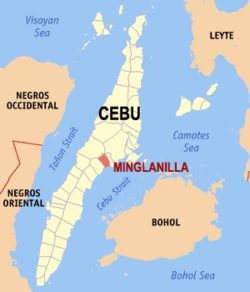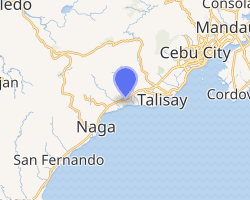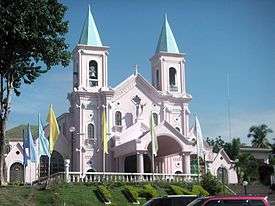Minglanilla, Cebu
Minglanilla, officially the Municipality of Minglanilla (Cebuano: Lungsod sa Minglanilla; Tagalog: Bayan ng Minglanilla), is a 1st class municipality in the province of Cebu, Philippines. According to the 2015 census, it has a population of 132,135 people.[3]
Minglanilla | |
|---|---|
| Municipality of Minglanilla | |
Immaculate Heart of Mary Church | |
 Map of Cebu with Minglanilla highlighted | |
OpenStreetMap 
| |
.svg.png) Minglanilla Location within the Philippines | |
| Coordinates: 10°14′42″N 123°47′47″E | |
| Country | |
| Region | Central Visayas (Region VII) |
| Province | Cebu |
| District | 1st district of Cebu |
| Founded | 1858 |
| Barangays | 19 (see Barangays) |
| Government | |
| • Type | Sangguniang Bayan |
| • Mayor | Elanito A. Peña |
| • Vice Mayor | Loben C. Geonzon |
| • Congressman | Eduardo R. Gullas |
| • Electorate | 64,568 voters (2019) |
| Area | |
| • Total | 65.60 km2 (25.33 sq mi) |
| Population (2015 census)[3] | |
| • Total | 132,135 |
| • Density | 2,000/km2 (5,200/sq mi) |
| • Households | 30,127 |
| Economy | |
| • Income class | 1st municipal income class |
| • Poverty incidence | 13.46% (2015)[4] |
| • Revenue (₱) | 266,403,577.84 (2016) |
| Time zone | UTC+8 (PST) |
| ZIP code | 6046 |
| PSGC | |
| IDD : area code | +63 (0)32 |
| Climate type | tropical climate |
| Native languages | Cebuano Tagalog |
Minglanilla is bordered to the north by the City of Talisay, to the west is the city of Toledo, to the east is the Cebu Strait, and to the south is the city of Naga.
Minglanilla lies within Metro Cebu. It is known as the "Sugat Capital of the South". (Sugat in Cebuano means meeting.) The Kabanhawan (Cebuano for "Resurrection") festival is held annually on Easter Sunday.
A big socio-religious event in Minglanilla is the Sugat, which attracts not only people from adjacent towns but also from Cebu city and further. On Black Saturday night, a public dance is held at the church plaza to witness the re‑enactment of the "meeting" of the risen Christ and his mother. Their images, borne on richly decorated carrozas, meet amidst joyous songs and the presence of child angels suspended by wires.
History
Father Sanchez, Minglanilla's first parish priest, is credited as the founder of the town in 1858. The roads and bridges were built by the same Fr. Sanchez together with Fr. Magaz.
There were a number of capitanes who headed the town during the Spanish era. The first capitan was Hilario Castañares. During the American regime the first was Canuto Larrobis. The first elected municipal mayor was Gregorio de la Calzada.
Buat was the former name of Minglanilla. It was the place where early settlers dried (buad/buat) their sea catches. But in 1858, it was renamed by Fr. Sanchez after a municipality called Minglanilla in Castilla–La Mancha, Spain.
The town suffered setbacks, among them during the Philippine Revolution of 1896-1898 when insurrectos burned down its municipal building and looted many houses. This event is remembered by a street named 18 de Julio (18 July). In 1942, its poblacion was razed to the ground by the Japanese in retaliation for the presence of the guerrillas in the town.
Geography
Minglanilla is located 15 kilometres (9.3 mi) south of Cebu City. It is bounded southwest by Naga; northwest by Toledo; northeast by Talisay; and southeast by the Bohol Strait. Its land area is 65.6 km2 (25.3 sq mi).
Barangays
Minglanilla comprises 19 barangays:
| PSGC | Barangay | Population | ±% p.a. | |||
|---|---|---|---|---|---|---|
| 2015[3] | 2010[5] | |||||
| 072232001 | Cadulawan | 4.0% | 5,321 | 3,986 | 5.65% | |
| 072232002 | Calajo‑an | 8.8% | 11,583 | 10,181 | 2.49% | |
| 072232003 | Camp 7 | 1.9% | 2,571 | 2,279 | 2.32% | |
| 072232004 | Camp 8 | 1.4% | 1,798 | 1,946 | −1.49% | |
| 072232005 | Cuanos | 2.1% | 2,809 | 2,499 | 2.25% | |
| 072232006 | Guindaruhan | 2.7% | 3,503 | 2,707 | 5.03% | |
| 072232007 | Linao (Linao-Lipata) | 9.8% | 12,943 | 11,432 | 2.39% | |
| 072232008 | Manduang | 1.6% | 2,147 | 1,968 | 1.67% | |
| 072232009 | Pakigne | 9.6% | 12,644 | 11,463 | 1.88% | |
| 072232010 | Poblacion Ward 1 | 1.6% | 2,087 | 1,987 | 0.94% | |
| 072232011 | Poblacion Ward 2 | 2.5% | 3,254 | 2,950 | 1.89% | |
| 072232012 | Poblacion Ward 3 | 2.2% | 2,884 | 2,765 | 0.81% | |
| 072232013 | Poblacion Ward 4 | 3.6% | 4,767 | 3,650 | 5.22% | |
| 072232014 | Tubod | 4.3% | 5,626 | 4,666 | 3.63% | |
| 072232015 | Tulay | 8.5% | 11,286 | 9,775 | 2.77% | |
| 072232016 | Tunghaan | 10.7% | 14,187 | 13,389 | 1.11% | |
| 072232019 | Tungkil | 9.9% | 13,109 | 10,789 | 3.78% | |
| 072232017 | Tungkop | 8.3% | 11,003 | 7,589 | 7.33% | |
| 072232018 | Vito | 6.5% | 8,613 | 7,157 | 3.59% | |
| Total | 132,135 | 113,178 | 2.99% | |||
Climate
The climate of Minglanilla is classified as Coronas type III, characterized by a dry season lasting from one to six months. There is no pronounced maximum rain period. The town is placed within the tropical rainforest type of world climate (Köppen type: Af) which has uniform high temperature and heavy precipitation distribution throughout the year.
| Climate data for Minglanilla, Cebu | |||||||||||||
|---|---|---|---|---|---|---|---|---|---|---|---|---|---|
| Month | Jan | Feb | Mar | Apr | May | Jun | Jul | Aug | Sep | Oct | Nov | Dec | Year |
| Average high °C (°F) | 28 (82) |
29 (84) |
30 (86) |
31 (88) |
31 (88) |
30 (86) |
30 (86) |
30 (86) |
30 (86) |
29 (84) |
29 (84) |
28 (82) |
30 (85) |
| Average low °C (°F) | 23 (73) |
23 (73) |
23 (73) |
24 (75) |
25 (77) |
25 (77) |
25 (77) |
25 (77) |
25 (77) |
25 (77) |
24 (75) |
23 (73) |
24 (75) |
| Average precipitation mm (inches) | 70 (2.8) |
49 (1.9) |
62 (2.4) |
78 (3.1) |
138 (5.4) |
201 (7.9) |
192 (7.6) |
185 (7.3) |
192 (7.6) |
205 (8.1) |
156 (6.1) |
111 (4.4) |
1,639 (64.6) |
| Average rainy days | 13.4 | 10.6 | 13.1 | 14.5 | 24.2 | 27.9 | 28.4 | 27.7 | 27.1 | 27.4 | 22.5 | 15.9 | 252.7 |
| Source: Meteoblue [6] | |||||||||||||
Demographics
| Year | Pop. | ±% p.a. |
|---|---|---|
| 1903 | 10,518 | — |
| 1918 | 12,590 | +1.21% |
| 1939 | 15,295 | +0.93% |
| 1948 | 15,774 | +0.34% |
| 1960 | 20,083 | +2.03% |
| 1970 | 28,880 | +3.70% |
| 1975 | 32,224 | +2.22% |
| 1980 | 38,504 | +3.62% |
| 1990 | 50,875 | +2.83% |
| 1995 | 62,523 | +3.94% |
| 2000 | 77,268 | +4.64% |
| 2007 | 101,585 | +3.85% |
| 2015 | 132,135 | +3.34% |
| Source: Philippine Statistics Authority[3][5][7][8] | ||
Economy
Minglanilla is a part of the Cebu metropolitan area.
Minglanilla is primarily a residential town, with most of its population commuting to Cebu City for work. Owing to its close location to Cebu City, which is only 15 kilometres (9.3 mi) away from the municipality, it hosts many subdivisions.
Prior to its suburbanization, Minglanilla's primary industry was agriculture. However, since the 2000s, when the municipality saw developments trickle down from Cebu City due to the city's own economic boom, the municipality has shifted into having a more service-driven economy.
Anjo World Theme Park is located in Barangay Calajo-an. It is the first amusement park in Cebu, and is located in the larger Belmont One development, which hosts a supermarket, a hardware, restaurants, among other retail components, also located within Barangay Calajo-an.[9][10]
The municipality will be the site of the Ming-Mori Reclamation and Industrial Park, a development which is envisioned primarily to host light industries, but also to other mixed-use developments as well.[11]
Culture

Churches
- Archdiocesan Shrine of the Immaculate Heart of Mary
- Snr. San Roque Parish
- Our Lady of the Rosary Parish
- Parroquia de Virgen de los Remedios
Festivals
- Sugat–Kabanhawan festival
- In its devotion to the celebration of Christ's resurrection, the municipality of Minglanilla has long held the distinction of being the "Sugat Capital of the south". Annually held every Easter Sunday, the occasion primarily focuses the re‑enactment of the meeting of the Risen Christ and the Sorrowful Mother – followed by a string of activities and events scheduled to take place throughout the day. As one of the biggest annually celebrated occasions of the municipality, the festival takes a direct translation in celebrating Christ's resurrection, with street dancing, a wide assortment of day games, and entertainment features. Essentially a socio-religious event, celebrations have played the role of host to a diverse range of organized contests, competitions and games, including a carabao race, a burda-making contest (burda = embroidery), and a mud volleyball tournament. Easter-egg hunts also are part of Sugat-Kabanhawan festivals, just as the street dancing and the ritual showdown have become mainstay staples of the festivals overall program flow.
- Annual Fiesta of the Immaculate Heart of Mary
References
- "Municipality". Quezon City, Philippines: Department of the Interior and Local Government. Retrieved 31 May 2013.
- "Province: Cebu". PSGC Interactive. Quezon City, Philippines: Philippine Statistics Authority. Retrieved 12 November 2016.
- Census of Population (2015). "Region VII (Central Visayas)". Total Population by Province, City, Municipality and Barangay. PSA. Retrieved 20 June 2016.
- "PSA releases the 2015 Municipal and City Level Poverty Estimates". Quezon City, Philippines. Retrieved 12 October 2019.
- Census of Population and Housing (2010). "Region VII (Central Visayas)". Total Population by Province, City, Municipality and Barangay. NSO. Retrieved 29 June 2016.
- "Minglanilla: Average Temperatures and Rainfall". Meteoblue. Retrieved 10 May 2020.
- Censuses of Population (1903–2007). "Region VII (Central Visayas)". Table 1. Population Enumerated in Various Censuses by Province/Highly Urbanized City: 1903 to 2007. NSO.
- "Province of Cebu". Municipality Population Data. Local Water Utilities Administration Research Division. Retrieved 17 December 2016.
- "Be part of Cebu's first: Belmont One announces its groundbreaking ceremony". Cebu Daily News. September 11, 2018. Retrieved July 26, 2020.
- Contratista, Ferliza (January 3, 2019). "First theme park to boost Minglanilla's tourism". Philippine Information Agency. Retrieved July 26, 2020.
- Almazan, Faye (July 25, 2020). "Cebu Landmasters project secures ECC from DENR". Manila Times. Retrieved July 26, 2020.
External links
| Wikimedia Commons has media related to Minglanilla. |